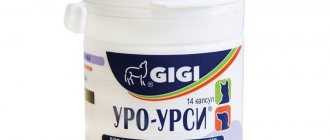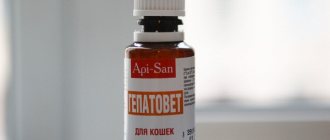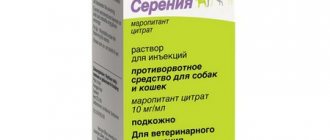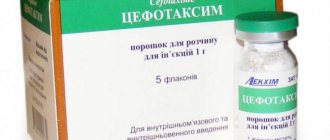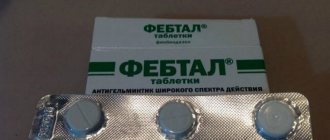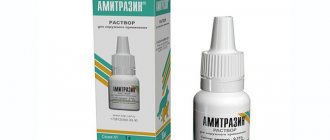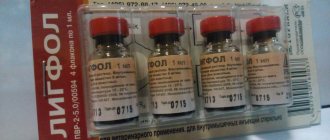COMPOUND
Active substance:
- Feliferon for cats, according to the instructions, 1 ml contains feline interferon with antiviral activity of 400,000 IU as an active ingredient
Excipients:
- dextran-40 50.00 mg
- sodium salt of ethylenediaminetetraacetic acid 0.07 mg
- sodium acetate 1.64 mg
- sodium chloride 5.84 mg
- polysorbate-20 0.10 mg
- glacial acetic acid about 0.0045 ml
- water for injection up to 1 ml
Release form and analogues
Interferon is produced in the form of a powder, scattered in ampoules of 2 ml. It is better to dilute this powder with special water for injection (sterile) up to the mark on the ampoule. But you can also use distilled or boiled water, which should be cooled. After dilution, you need to shake the ampoule so that the powder is completely dissolved.
The drug should be stored at a temperature of 4 to 10 degrees Celsius. The shelf life of Interferon is 2 years from the date of manufacture written on the packaging, which contains 10 ampoules.
Well-known analogues of Interferon are:
- "Amiksin".
- "Laferobion".
- "Viferon".
- "Nazoferon".
- "Feliferon".
PHARMACOLOGICAL PROPERTIES OF FELIFERON
Pharmacological group: immunomodulators, drugs with antiviral activity. Feliferon for cats has an immunostimulating and antiviral effect.
The mechanism of action consists of:
- increased phagocytic activity of macrophages in cats
- increasing the specific cytotoxicity of lymphocytes
- increasing the resistance of healthy cells of the cat’s body to infection with viruses
- in suppressing the reproduction of RNA and DNA viruses in infected cells
According to the degree of impact on the cat’s body, Feliferon is classified as a low-hazard substance
(grade 4), in recommended doses does not have a skin irritant or resorptive toxic effect.
Advantages
- Immunostimulating effect. Its essence is the activation of leukocytes, which are responsible for eliminating viral infections.
- Antiviral effect. Protein synthesis in affected cells slows down.
- Feline interferon is specifically designed for these animals, which contributes to more effective treatment and the formation of positive dynamics.
- The animal does not get used to the medicine.
- There are no side effects associated with the toxicity of the product.
- There are no restrictions on the age of the animal. Feliferon can be used for kittens from the first days of life.
Why use Feliferon to treat cats?
According to the instructions, feliferon is designed for the treatment of viral diseases of cats. Field studies of cats with calicivirus infection have shown a reduction in the severity and duration of clinical signs associated with the virus. The drug has also been used in the adjunctive therapy of cats with infectious peritonitis with uncertain clinical results.
Feliferon for cats has been used experimentally in the treatment of feline viral infections, including leukemia, immunodeficiency and coronavirus infection.
Feline interferon given prophylactically or therapeutically to cats experimentally infected with FIP does not reduce mortality. However, the high-dose protocol resulted in transient suppression of clinical signs and decreased serum antibody titers to FIP with increased survival time (weeks) compared to untreated cats. There are no good studies on the effect of this treatment on spontaneously occurring FIP infection, although one protocol has been described using human interferon alpha 30 IU/day orally for 7 days on alternating weeks for 6–7 weeks.
Feliferon in cats is indicated for the treatment of herpes keratitis.
Trials are currently underway to examine the potential benefits of interferon therapy for feline chronic gingivostomatitis.
What is interferon
Antibiotics help us fight bacteria. But with viruses it’s not so simple. For a long time, there were no weapons against viral infections. But today this is no longer the case. In addition to umifenovir and neuraminidase inhibitors, we can counteract viruses with interferon-based drugs. This affordable type of therapy became especially relevant when outbreaks of the new viral disease COVID-19 hit humanity. According to recent studies, high doses of interferon are highly effective in the treatment of this serious illness and other acute respiratory viral infections.
In China, the possibilities of interferon therapy were studied in 77 adults with moderate COVID-19. The study showed that interferon-alpha-2b helps reduce virus concentrations in the upper respiratory tract of subjects, and also prevents the development of inflammation in the body.
Interferon is not one compound. Interferons include a whole group of cytokine proteins with similar properties. All of them are produced by human cells as protective agents when attacked by viruses, bacteria, and also in response to the influence of certain low-molecular substances.
Perhaps the most important property of interferons is the ability to inhibit the reproduction of viruses, and in a very elegant way. Interferons themselves do not harm viruses, but they force cells at the site of infection to produce a cascade of enzymes that block the synthesis of viral proteins (Fig. 1). But that's not all. Interferons, in response to a viral infection, activate many genes responsible for protecting the body from enemy invasions, activate the immune system and push infected cells to self-destruction - apoptosis.
Figure 1. Interferons attach to cells and induce them to produce antiviral enzyme proteins.
Illustration: MedPortal
The three main types of interferons include:
- alpha interferons (produced by leukocytes),
- interferons beta (produced by fibroblasts),
- interferons-gamma (produced by cells of the immune system).
Alpha interferons show high effectiveness in the treatment of severe viral infections (Fig. 2) and those acute respiratory viral infections that we encounter every spring and autumn. One of the most famous is interferon-alpha-2b (IFN-alpha-2b). It is used as a means of therapy against influenza and other diseases associated with damage to the body by viruses.
What is ARVI?
The culprits of ARVI or colds are viruses. Most often these are influenza (types A and B viruses), parainfluenza, adeno- and coronaviruses. The latter includes the new virus SARS-CoV-2, responsible for the COVID-19 pandemic. ARVI is characterized by:
- airborne transmission (the virus travels through the air along with microdroplets released when sneezing or coughing and enters the body, settling on the mucous membrane of the nasopharynx),
- damage to the respiratory system (infection develops in the upper respiratory tract, gradually affecting the lower ones),
- rapid development and acute course (colds are usually accompanied by fever, muscle aches, severe fatigue, sore throat, cough, congestion and runny nose).
Most often, ARVI occurs in a relatively mild form and does not last long, but sometimes a cold ends in complications. If symptoms do not subside for more than a week, the likelihood of developing bronchitis, sinusitis, pneumonia, myocarditis (inflammation of the heart muscle), otitis media and even meningitis increases. Therefore, it is necessary to treat ARVI, not only by relieving the symptoms, but also by supporting the body in the fight against the virus.
INDICATIONS
Feliferon is prescribed to cats according to the instructions for use for therapeutic and prophylactic purposes for:
- feline herpesvirus (rhinotracheitis)
- panleukopenia
- calicivirus
- anemia and hypovitaminosis
- in the postoperative period
- in the postpartum period
- secondary immunodeficiency
- gastrointestinal
- invasive diseases
- acute respiratory
- poisoning
- other diseases of viral or mixed etiology
MODE OF APPLICATION
Feliferon solution for injection is administered intramuscularly to cats. If there is a threat of infection, the drug is prescribed at a dose of 200,000 IU per animal, twice with an interval of 48 hours. For the treatment of cats with viral, bacterial and mixed diseases, Feliferon is administered in a daily dose of 200,000 IU, for 5-7 days in combination with antibiotics, serum and immunoglobulin preparations, in accordance with the instructions for their use.
In severe cases of the disease and mixed infections, it is recommended to increase the average therapeutic dose by 2 times - 400,000 IU.
No overdose symptoms have been identified when using the drug. Avoid missing the next dose of Feliferon in cats, as this may lead to a decrease in therapeutic effectiveness. If one dose is missed, it is necessary to administer it to the cat as soon as possible, then the interval between administrations of the drug does not change.
Side effects
When using Interferon, no side effects were identified in cats and female cats, as well as no contraindications . However, it is not recommended to use this medicine without consulting a veterinarian.
Thus, “Interferon” for cats and dogs becomes the best immunostimulating agent that allows you to confidently defeat any respiratory diseases. The drug activates the body's cells, helping to build a protective barrier against pathogenic bacteria and viruses.
Viral and infectious diseases of cats are treated with a complex of medications; immunomodulators are necessarily included in therapeutic regimens. One of the popular and effective drugs in this group is Feliferon injection solution, which suppresses the activity of viruses and accelerates recovery.
Prevention measures:
If allergic reactions occur or if the drug accidentally enters the human body, you should immediately contact a medical facility (bring the instructions or label with you).
People with hypersensitivity to the components of the drug should avoid direct contact with the drug. When working with Feliferon for cats, you should follow the general rules of personal hygiene and safety precautions provided for when working with medications.
If a person accidentally comes into contact with the medicinal product with the skin or mucous membranes of the eyes, they must be rinsed with plenty of running water.
Empty drug bottles must not be used for household purposes; they must be disposed of with household waste.
How to use Interferon alpha spray against coronavirus correctly
Interferon alpha in the form of a spray (Genferon, Hippferon) is used against coronavirus for prevention and at the first signs of illness (fever, nasal congestion, sore throat) in the dosages indicated in the table. One press of the sprayer is 1 dose; it is necessary to administer the drug in the recommended quantities into both nasal passages.
| Age | Prevention of coronavirus (during the epidemic) | At the first symptoms (total 5 days) |
| Up to a year | 1 dose 1 time per day | 1 dose 5 times a day |
| From 1 to 3 years | 2 doses 1 time per day | 2 doses 3-4 times a day |
| 3-14 years | 2 doses 1 time per day | 2 doses 4-5 times a day |
| From 15 years old | 2 doses 1 time per day | 3 doses 5-6 times a day |
If there was hypothermia or probable contact with a patient, then the prophylactic dose is administered not once, but twice (morning and evening). It is not recommended to instill other drugs into the nasal passages together with interferon, as the risk of drying out the mucous membranes increases.
Learn about essential antimicrobials in animals
- Trichopolum instructions for veterinary medicine
- Instructions for the use of the antibiotic Baytril in animals
- Instructions for use of metronide
- Instructions for ceftriaxone preparations for animals
- Use of Metrogyl in veterinary medicine
- Instructions for doxycycline in animals
- Metronidazole (Metronidazole) for animals (instructions for use in veterinary medicine, doses, indications and contraindications)
- Atovaquone (ATOVAQUONE)
- Azithromycin, instructions for animal therapy
^Top
